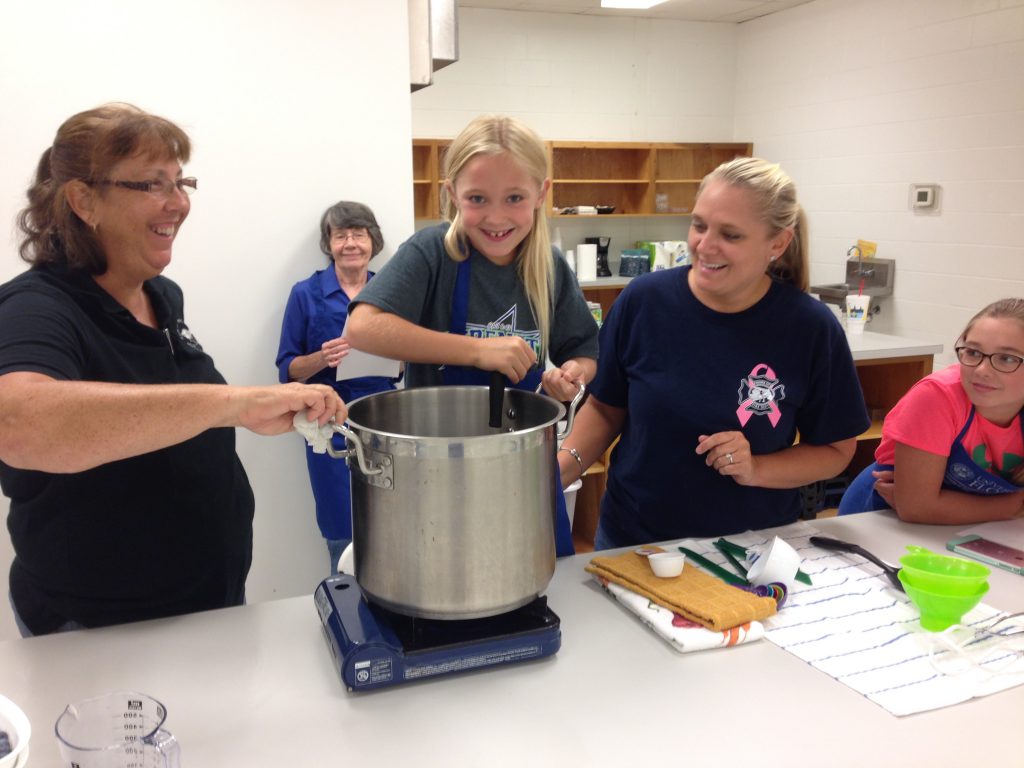
by Angela Hinkle | Aug 23, 2018

Healthy Pantry
Photo Source: Angela Hinkle
We eat to survive, right? Yes, but when you really think about it, we eat to thrive. Food is more than calories for energy. Food brings family and friends together. It provides comfort. It makes our bodies healthy and can protect us from diseases. The next time you give to a food pantry, think about what you can give to help those in need thrive, not just survive. So, how do you donate food to thrive?
A Balanced Diet
It’s important to eat from every food group every day. It’s important to give those in need the chance to eat every food group every day. This way, they get a variety of nutrients needed for healthy bodies. Choose healthier choices from each food group. See https://www.choosemyplate.gov/ for more information.
Fruits & Veggies: Half MyPlate
- Fruits and vegetables provide so many good vitamins, minerals, fiber, and water.
- All forms count – canned, frozen, fresh, dried, and juice.
- Canned fruit in 100% juice (Lite or heavy syrup equals a little or a lot of added sugar.)
- Juices that are 100% fruit or vegetables.
- Low- or no-sodium canned vegetables (Higher sodium intake tends to go hand-in-hand with higher blood pressure.)
- Try to stay away from high-fat, high-sodium, and high-sugar syrups and sauces.
- Packaged dried fruits and veggies are both popular now.
- The more fruits and vegetables, the better!
Whole Grains
- The whole edible part of the grain plant gives us fiber and loads of nutrients to keep us healthy. They even have special parts that help fight diseases.
- Look for the word whole at the beginning of the ingredient list.
- Help pantries stock whole grain crackers, hot and cold cereals, and tortillas. Donate whole grain pasta and brown rice.
Lean Proteins
- Protein helps build and repair tissue.
- Protein provides the building blocks of muscles, bones, skin, and blood.
- Go for lower-sodium and lower-fat choices. (Most of us over the age of two don’t need that extra fat.)
- Donate tuna, chicken, or salmon in water.
- Peanut butter is always popular.
- Try offering a variety of packaged seeds and nuts.
Dairy
- The calcium in dairy foods makes strong bones and teeth.
- Try low-fat versions of shelf-stable milk.
- Non-fat dry milk is great for sauces and casseroles as well as drinking. (If used for drinking, it tastes best to add the coldest water possible.)
- Low-fat yogurt and cheeses are a nice complement for pantries with refrigeration.
- For those who can’t have dairy, offer calcium-fortified soy or almond milk, cereal, or orange juice.
So don’t just think “feed them” when you donate, think “feed them well.” Donate beyond survive. Donate to thrive.

by Dorothy C. Lee | Jul 30, 2018

Instant Pot settings display. Photo source: Wendy Meredith
An Instant Pot Pressure Cooker is a small electronic multi-cooker appliance that can function as a pressure cooker, slow cooker, rice cooker, steamer, warmer, and more. It is often referred to as an Instant Pot. It is currently the hottest trend in home cooking.
An Instant Pot Cooker can prepare just about any type of food you can imagine. Poultry, beef, and pork recipes, soups, stews, bread, and even desserts.
Considering today’s fast paced lifestyle the Instant Pot is a time saving kitchen helper. Spend a few minutes preparing the recipe ingredients, program the Instant Pot and relax. The Instant Pot cooking method takes the stress out of long cooking times and of meal preparation.
Instant Pot cookers are available in a variety of sizes, styles, and functions. The function of an Instant Pot is based on the model purchased. Many brands are available. Basic functions present in most models consist of slow cooker, pressure canner, steamer, rice cooker, yogurt maker, egg cooker, sauté or browner, and warmer.
When purchasing a multi-cooker consider the usage and quantity of food to be prepared. A 3-quart cooker is just the right size for single servings. Family sizes are available as 6-quart (4-6 servings) or 8 -quart (6-8 servings).
The benefits of an Instant Pot cooker are numerous. No need for constant or frequent stirring, no worry about overcooking or burning, saves energy based on quick cooking times required for recipes and less small kitchen appliances needed for preparation.
Traditionally beef stew and less tender cuts of meat take hours of cooking to render tender. The Instant Pot Cooker dishes up these delicious dishes in under an hour.
Corned Beef Cabbage*
2 pounds corned beef
2 cups chicken broth
2 cups water
3 bay leaves
8 peppercorns
¼ cup apple cider vinegar
8 medium red or white potatoes
8 cups coarsely sliced cabbage
Place beef in cooker. Add stock, water, bay leaves, peppercorns, and vinegar in cooker. Cook for 90 on meat/stew setting. Remove corned beef. Add vegetables; cook on high pressure for 4-5 minutes.
*Follow directions listed on Instant Pot instruction manual for programming cooker.
Instant Pot cooking is easy, economical and quick.
Recipe adapted from Cooks’ Essentials.

by Angela Hinkle | Jul 11, 2018
The pickin’ is plentiful and life is good. Now is the time to take advantage of summer’s bounty. Summer produce is colorful and healthy. It tastes amazing. And right now, it’s everywhere!
Fruits and Veggies in Season
Buying summer produce now means you get fruits and vegetables that taste their best. See Panhandle Produce in Season for what’s in season in the Florida Panhandle. Because this is the easiest time to grow them, they also cost less than at other times of the year. You also may get to learn more about where your food comes from. This is a great time of year to buy local. Speaking of which…

Visit a U-Pick farm for fresh, local produce.
Photo source: Alex Hinkle
U-Pick Farms
When’s the last time you or your kids picked your own food? U-Pick farms are a great way for the whole family to enjoy the outdoors. (Hint: for max comfort and safety, go in the earliest/coolest part of the day.) Picking from a U-Pick helps you get delicious food at a good price. It also helps local businesses thrive. You can meet the local farmers in your area. You usually can get easy, tasty recipe ideas and you can even make new friends. (Working to pick your own food also can make you appreciate how hard it is to have the job of farmer.) To find the closest U-Pick farm in your area, contact your local UF/IFAS Extension Office.
Save Some for the Colder Months
Whether from a U-Pick, farmer’s market, or grocery store, sometimes you just can’t eat all that great produce right now. What to do? Canning or freezing are excellent options. For information on freezing vegetables, see UF IFAS Freezing Vegetables. For fruits like berries, rinse berries well and let them dry on paper towels. Place in plastic zippered bags and freeze. Then just take out the amount you need for blueberry muffins in January – Yum! Or if you live in the South, it’s easy to make cold smoothies in the blender any time of year.

Fresh-picked blueberries are perfect in smoothies and salads.
Photo source: Alex Hinkle
Half MyPlate
The USDA (United States Department of Agriculture) recommends half of your plate be fruits and veggies. Eating in this way gives your body the nutrients it needs to get healthy and stay healthy. Vitamins, minerals, water, and fiber are packed into summer produce. Eat a variety. Try produce in every color, texture, shape, and size. To pack a tasty, healthy wallop for your next meal, make a hot multi-veggie hash alongside a cold refreshing fruit salad. For more ideas on how to add more fruits and veggies into your day, go to Liven Up Your Meals with Fruits and Veggies.
Summer’s Bounty – get it now, enjoy it now!

by Heidi Copeland | Jul 11, 2018

Never eat wild mushrooms – many are poisonous.
Photo source: UF/IFAS Northwest District
Here, there, and everywhere!
With all the rain of late, there seems to be an interest in mycology. You know, the fruiting body of fungi called mushrooms! Edible mushrooms in particular.
It is not unusual; our subtropical summer weather tends to make some fungi flourish! Moreover, apparently, there is a bumper crop of fungi this year. Phone calls to the University of Florida IFAS Extension office about eating mushrooms has increased. Individuals have even brought mushrooms to the office, inquiring if they are of the edible variety.
Our reputation as Extension Agents certainly would be damaged if we did not adhere to a few rules… always read a label, use research-based information, and NEVER tell anyone that a mushroom is edible. It is not that there are not delicious wild mushrooms out there; a recent July 2017 publication of Microbiology Spectrum estimates millions of species. However, even the scientists do not agree, as only about 120,000 of them have been described so far. Not all are edible. Some fungi are poisonous to the point of being deadly.
Dr. Matthew Smith, Assistant Professor in the Department of Plant Pathology, knows a lot about mycology. In fact, he also is curator of the UF Fungal Herbarium (FLAS), managed by the UF Department of Plant Pathology at the Florida Museum of Natural History in Gainesville. The Fungal Herbarium is a valuable resource; its collections have many important aspects, including information about fungi that are deadly poisonous to humans and pets when consumed.
In addition, the UF Fungal Herbarium is participating in a National Science Foundation-funded project to digitize and database as many US macrofungi collections as possible. This project (The Macrofungi Collection Consortium) includes 34 institutions in 24 states. The project began in July 2012 and will aim to capture data for roughly 1.3 million fungal specimens. Persons interested in visiting the fungal herbarium should contact Dr. Matthew Smith, trufflesmith@ufl.edu.
With that said, there is enough scientific research out there to conclude mushroom identification is indeed difficult. Many mushrooms look similar, but are oh so different!
If you are truly interested in eating what you forage, MAKE time to study with experts! Mushrooms you plan to eat that are not identified correctly could send you to the emergency room … or worse. The toxicity of a mushroom varies by how much has been consumed. Poisoning symptoms range from stomachaches, drowsiness, and confusion to heart, liver, and kidney damage. The symptoms may occur soon after eating a mushroom or can be delayed for six to 24 hours.
Delayed symptoms are common. Seek help immediately if you think you may have eaten a poisonous mushroom, even if there are no obvious signs of toxicity. Call the Poison Center’s 24-hour emergency hotline at 1-800-222-1222. You will receive immediate, free, and confidential treatment advice from the poison experts.
And if you are determined to make foraging for food a recreational hobby or even want to learn more about what is in your Florida yard, Common Florida Mushrooms by Dr. James Kimbrough, Emeritus Faculty, University of Florida’s Institute of Food and Agricultural Sciences, identifies and describes 268 species of mushrooms found in the Sunshine State.
Most importantly, teach your children to NEVER eat any mushroom picked from the ground. It is indeed better to be SAFE than sorry!

by Heidi Copeland | Jul 11, 2018

Enjoy a scoop of ice cream in honor of National Ice Cream Month.
Photo source: UF/IFAS Northwest District
In 1984, President Ronald Reagan declared July as National Ice Cream Month and the third Sunday in July (July 15, 2018) as National Ice Cream Day! Essentially, the entire month of July is supposed to be celebrated with “appropriate ceremonies and activities” involving ice cream! Ice cream is both nutritious and delicious – eaten in moderation, of course.
However, choosing ice cream can be confusing! Categorically, ice cream is included in the frozen dessert category of the frozen food industry. This category of foods comprises groupings such as regular and low-fat ice cream, frozen yogurt, sherbets, and other frozen sweet treats.
According to the International Dairy Foods Association (IDFA), FUN ice cream facts include:
- Regular ice cream is the most popular category of frozen desserts in the U.S.
- Low-fat ice cream is the second most popular category.
- The United States eats the second largest amount of ice cream per capita.
- The average American consumed 13 pounds of ice cream in 2016.
- Ice cream companies made more than 898 million gallons of regular ice cream in 2015.
- A typical serving size is ½ cup or a scoop about the size of a tennis ball.
What really is ice cream? Real ice cream or ice-cream is a frozen sweet made from dairy products, such as milk and cream, combined with flavorings and sweeteners, such as sugar. American federal labeling standards require ice cream to contain a minimum of 10% milk fat per 1/2 cup serving and 20% total milk solids by weight. A bit of air is slowly added to this slow-stirred mixture while chilling to prevent large ice crystals from forming. A term used in processing commercial ice cream is overrun. Overrun means the liquid dairy mixture, once completely chilled, can have expanded up to double its original volume by the incorporation of air. The addition of air (although not an ingredient on the label) results in a smoothly textured ice cream free from palpable ice crystals or sandiness.
Overrun (air) helps explain the vast price discrepancy between ice cream brands. Typically, the more expensive brands generally use more and better quality ingredients and have less overrun, whereas less expensive ice cream brands tend to use the minimum amounts of ingredients required by law and more overrun. In the U.S., ice cream is sold by volume… hence, the standard serving size of ½ cup.
There are so many variations to the basic ice cream recipe. When egg yolk solids are added to ice cream, the name has to reflect this. “Frozen custard” or “French ice cream” or “French custard ice cream” is ice cream with the added egg yolk.
Premium brand ice creams tend to use a higher than standard ice cream recipe with higher fat content and more expensive, better quality ingredients… and less air.
Ice-milk is no longer made. A 1994 change in rules allows ice milk to be labeled as low-fat ice cream. Low-fat ice cream, by law, must contain 50% or less fat than a similar food. Note that the law says nothing about calories. A light ice cream may be just as high in total calories as ice cream because of the addition of other ingredients.
Frozen yogurt, made from yogurt, is a dairy product, with the addition of various sugars and flavorings. However, yogurt’s reputation for being low in calories is not always accurate and, unlike ice cream, there are no federal standards of any kind for frozen yogurt.
Gelato is a type of soft frozen dessert containing a relatively small amount of air. This makes the product dense, rich, and creamy. Gelato can be made with milk, cream, various sugars, and flavoring such as fresh fruit. In the United States, there is no federal standard definition for gelato set forth by the U.S. Food and Drug Administration.
Are sorbet, sherbet, and sherbert all the same? Despite the fact that the legal definitions of sherbet and sherbert can be used interchangeably, sherbet/sherbert is a frozen fruit and dairy product that contains anywhere from 1-2 percent milk fat from milk or cream and 2-5 percent total milk solids. On the other hand, sorbet generally implies a fruit-based frozen dessert with little to no dairy (but may contain egg white). The term sorbet is an unregulated industry standard. However, the industry wants them free from surface crustation, brittleness, syrup bleeding, and large ice crystals.
Confused yet? The frozen dessert market continues to evolve with novelty-frozen inventions made with nondairy to mimic ice cream. Welcome, delicious dairy-free almond, coconut, cashew and soymilk frozen desserts. Notice, these products are not called ice cream but non-dairy frozen desserts. Nevertheless, they are so smooth, creamy, and delicious, you might not even notice.
In 1984, when President Reagan crafted the amusing proclamation to eat ice cream, folks didn’t have SO much to choose from. You do! Enjoy a frozen treat but know what you are buying. Not all frozen treats are in fact ice cream! When you are reading nutrition labels, it is important to look at the whole picture. You can learn a lot from a label!
by Melanie Taylor | Jul 8, 2018

Youth learn food preservation skills. Photo source: Melanie Taylor
At this point in the summer, many parents are at a loss for what to do to keep their children engaged and “off the couch.” How about a focus on healthy eating and food preservation? If you have a backyard garden be sure to pick the fruits and vegetables at their peak readiness. If you do not have a garden make a family trip to the local farmers market and/or a local u-pick farm.
Of course, fresh fruits and vegetables are full of nutrition and taste, but if you have or buy more than your family can eat in a few days’ time, be sure to make preparations to teach your children how to preserve those foods to eat later in the year. There is nothing more enjoyable than having fruit jam on biscuits or summer vegetables in your soup during the cold depths of winter.
There are six different methods of food preservation to teach your children. They are boiling water/water bath canning, making jam, pickling, freezing, drying, and pressure canning. The easiest method being freezing and the most complex and time consuming being pressure canning. No matter which ones you choose to teach your children be sure to follow valid recipes and procedures. Family and Consumer Science Extension Agents always recommend using the most current recipes and procedures from The National Center for Home Food Preservation, which are maintained at https://nchfp.uga.edu/. The National Center for Home Food Preservation is your source for current research-based recommendations for most methods of home food preservation. The Center was established with funding from the Cooperative State Research, Education and Extension Service, U.S. Department of Agriculture (CSREES-USDA) to address food safety concerns for those who practice and teach home food preservation and processing methods. Many of the recipes are available for free on the website, or you can order the 6th edition of the “So Easy to Preserve” food preservation book at https://setp.uga.edu/.
Specific to children, there is also a Put It Up! Food Preservation for Youth curriculum through the University of Georgia, which is a series of informal educational lessons that guide youth to explore and understand the science of safe food preservation. This free curriculum can be found online at https://ugeorgia.ca1.qualtrics.com/jfe/form/SV_a5Y4IfBZ2Vh0EIt after a quick questionnaire of how you plan to use the curriculum.
Teaching these food preservation skills to your children will be a fun-filled and very educational opportunity. Be sure to use the above resources to assist you in the food safety methods to be certain your products are safe for consumption. Enjoy this special time in the garden and kitchen with your children this summer.
Resources:
National Center for Home Food Preservation https://nchfp.uga.edu/
“So Easy to Preserve” https://setp.uga.edu/
Put It Up! Food Preservation for Youth https://ugeorgia.ca1.qualtrics.com/jfe/form/SV_a5Y4IfBZ2Vh0EIt











